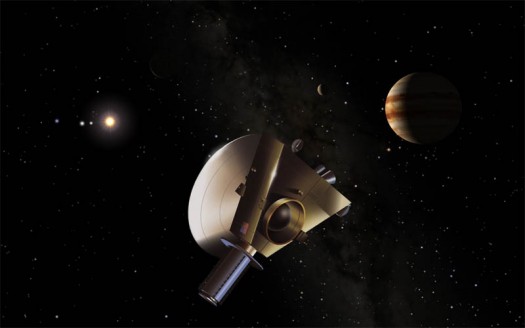Utterly Alien
April 2005By Dr. Tony Phillips
Dr. Tony Phillips;>> Macro menumgr_macro_spaceplaceimage not found <<
The brightest star in the sky is the Sun, so distant and tiny you could eclipse it with the head of a pin. There's a moon, too, so big you couldn't blot it out with your entire hand. Together, moonlight and sunshine cast a twilight glow across the icy landscape revealing . . . what? twisted spires, craggy mountains, frozen volcanoes?
No one knows, because no one has ever been to Pluto.
"Pluto is an alien world," says Alan Stern of the Southwest Research Institute in Colorado. "It's the only planet never visited or photographed by NASA space probes."
That's about to change. A robot-ship called New Horizons is scheduled to blast off for Pluto in January 2006. It's a long journey: More than 6 billion kilometers (about 3.7 billion miles). New Horizons won't arrive until 2015.
"I hope we get there before the atmosphere collapses," says Stern, the mission's principal investigator. Winter is coming, and while it's warm enough now for Pluto's air to float, it won't be for long. Imagine seeing a planet's atmosphere collapse. New Horizons might!
"This is a flyby mission," notes Stern. “Slowing the spacecraft down to orbit Pluto would burn more fuel than we can carry." New Horizons will glide past the planet furiously snapping pictures. "Our best images will resolve features the size of a house," Stern says.
The cameras will also target Pluto's moon, Charon. Charon is more than half the size of Pluto, and the two circle one another only 19,200 kilometers (12,000 miles) apart. (For comparison, the Moon is 382,400 kilometers [239,000 miles] from Earth.) No wonder some astronomers call the pair a "double planet."
Researchers believe that Pluto and Charon were created billions of years ago by some terrific impact, which split a bigger planet into two smaller ones. This idea is supported by the fact that Pluto and Charon spin on their sides like sibling worlds knocked askew.
Yet there are some curious differences: Pluto is bright; Charon is darker. Pluto is covered with frozen nitrogen; Charon by frozen water. Pluto has an atmosphere; Charon might not. "These are things we plan to investigate," says Stern.
Two worlds. So alike, yet so different. So utterly alien. Stay tuned for New Horizons.
Find out more about the New Horizons mission at pluto.jhuapl.edu/. Kids can learn amazing facts about Pluto at spaceplace.nasa.gov/en/kids/pluto.

New Horizons spacecraft will get a gravity assist from Jupiter on its long journey to Pluto-Charon. Credit: Southwest Research Institute (Dan Durda)/Johns Hopkins University Applied Physics Laboratory (Ken Moscati).
This article was provided by the Jet Propulsion Laboratory, California Institute of Technology, under a contract with the National Aeronautics and Space Administration.



